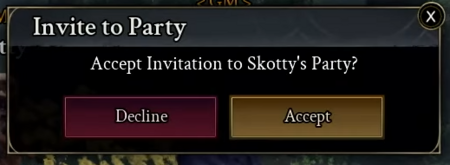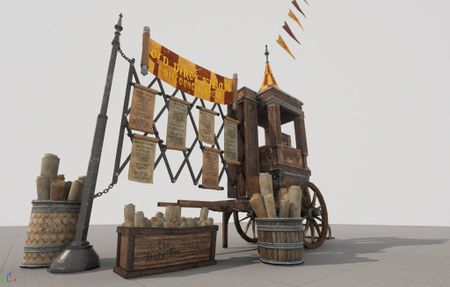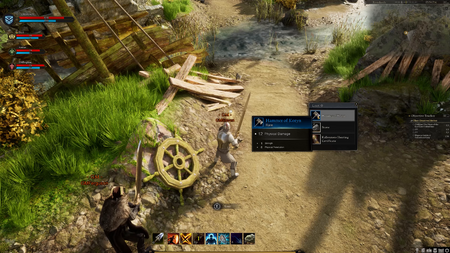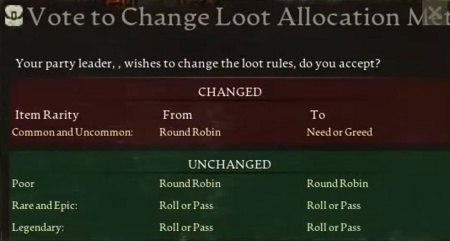Group dynamics
Group dynamics aim to bring players together.[2]
- One of the main philosophical pillars behind our design was that PvE must be impactful and inclusive. We want solo players, small groups and large groups to all have a home within our system.[3]
- Ashes of Creation is in development. These systems could change through playtesting and player feedback.[2]
Group sizes
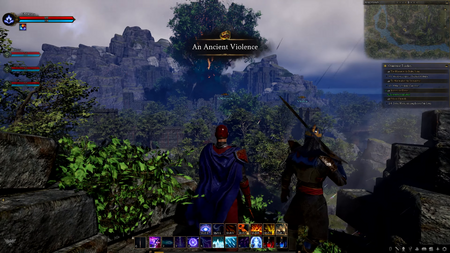
We're not creating a solo game, but it doesn't mean that we don't offer gameplay that is solo centric as well: It lives in addition to the social aspect of What MMOs provide; and so part of what we do in order to to give that element of gameplay is we have quest lines that are devoted towards solo players. We have hunting grounds. Obviously one of the benefits of being a solo player is you get to keep everything that drops. You don't have to share loot with a party or with friends; that's one benefit of being a solo player. But it's going to be more difficult to overcome challenges; and those individuals who are up to taking that additional level of of difficulty are going to excel perhaps in their character progression a bit faster than those who are more group-centric. It's going to be a little bit of a roll of the dice there because there are loot tables, there are reward tables that accompany that, but it's important to note that from a content perspective Ashes of Creation is looking to fulfill both that solo-oriented mind in gameplay as well as the group and social experience; and a lot of times those paths diverge: They move apart, they come back together; and that process is going to be seen throughout the leveling in Ashes of Creation where you'll have more opportunities for solo gameplay and some opportunities for group gameplay.[5] – Steven Sharif
Ashes of Creation is designed for solo players as well as large and small groups.[5][6][7]
- The idea behind an 8-person group is to allow us to really amplify party roles, and to create a need for each of the archetypes in every party.[2]
- Raids will have 40 man groups.[8]
- Content will be tailored for 40, 16 and 8 person group sizes.[9]
- Arenas will have 1 man, 3 man, 5 man and possibly 20 man Free-For-All (Deathmatch) group sizes.[10]
- Castle sieges are expected to have at minimum 250x250 players to be on a single battlefield, with the possibility of increasing this to 500x500 over time.[12][13][14][15]
- The minimum goal is 500 players on a single battlefield. I think we will be able to hit 500vs500 but we shall see.[15] – Steven Sharif
Solo players
Ashes of Creation provides gameplay options for solo oriented players.[5]
- For those solo players who don't really care about finding a community to play with but they want to have one when they need it, there's going to be a lot of opportunities from a dialogue perspective, in-game chat options; you can join as part of citizenships: there's a lot of pseudo factions there- social organizations that give you an in to other players without the strong bonds that typically come with guild-oriented organizations; and I think that that's a comfortable medium between the two.[5] – Steven Sharif
- Certain quest lines and hunting grounds are devoted towards solo players.[5][3]
- Node citizenship and social organizations provide the ability to interact without the strong bonds that typically come with guild-oriented organizations.[5][17]
- Mechanics exist within larger conflicts for small groups and solo players to impact the battle.[18]
- This includes systems that will likely focus on single group sized participants while the larger battle is occurring.[18]
Balancing
- Balancing in Ashes of Creation is group focused not based on 1v1 combat.[19][20][21]
- 1v1 matchups will have a rock-paper-scissors dynamic, where one class will be superior to another.[19][21]
- There will be match ups in 1v1s where one class will be superior to another; and that application should be a rock-paper-scissors dynamic. We want there to be counter-play between the different classes... Instead it's going to be a group focused balance, where as long as you have the diversity of classes present, that's going to be an equal level playing field. It's going to be very dependent on skill and strategy.[21] – Steven Sharif
- Balance-wise, there's a number of different interactions mechanically that you have within an ability that you can adjust in order to balance its power. The most most common ones are: Cooldown, Mana consumption, Damage done, Effect status conferred, Promotion of that effect status, Range.[22] – Steven Sharif
- Alpha-1 testing was focused on core functionality rather than combat balance.[23]
- Alpha-2 testing will begin to focus on balancing once populations and encounters have been put in place and are deep in testing.[19][24]
- When we move into Alpha 2 and we have a lot of data that's supporting the use of these particular abilities in combat settings, how often they're used, how often they result in death, what the average damage done by this archetype is comparatively to other damage done by different archetypes: All of that data gets logged and all of that data gets queried in order for us to refine the abilities so that they live in the environment we want them to. Now, that's not to mean that we're going to have a perfect balance across the board between the archetypes. Again, we're taking a rock-paper-scissor approach to balance, which means that some archetypes will do better against other archetypes and vice versa; and we're also not creating an environment where we want to have 1v1 balance. We are focused around group balance. Group composition is important.[19] – Steven Sharif
- The sixty four (64) classes are partitioned into eight primary archetypes. Balancing of active skills only relates to these eight primary archetypes.[20][25]
- Certain secondary archetypes are capable of "bridging the gap" between their counterpart.[30]
- Even though augments do radically change the way your active skills provide you abilities, there's still a primary focus on the base archetype itself and not the 64 whole classes.[20] – Steven Sharif
- Certain archetypes are capable of moving the gap between their counterpart per-se. If I am a Tank archetype and a Mage is my counter, I can take a Mage secondary and bridge the divide slightly; and then move my identity that direction ever so slightly.[30] – Steven Sharif
Group finder
There will not be a generalized group finder in Ashes of Creation, instead Bulletin boards are used to encourage localized grouping.[31]
Bulletin boards
Bulletin boards are available within nodes[31] and player taverns.[33]
- A market UI lists the current items available for sale in the node and in the same economic region.[34][35]
- This includes items for sale in player stalls and auction houses.[36]
- Players can't purchase directly from the market UI. Instead it gives the location of player stalls where the items may be purchased.[37]
- Encourage localized grouping.[33]
- Enable posting of jobs.[31]
- Quest sponsorship.[38]
Loot
- Mobs drop glint, Items, and crafting materials in preference to gold.[40][41]
- Glint is not bound to a specific region and can be also dropped by players on death as stolen glint, based on applicable death penalties.[42][43][44][45][40][46]
- The rarity of glint increases with the mob's level.[47]
- Loot tables are disabled for player controlled monsters.[48]
- There is a small RNG chance of looting rare and legendary items or crafting materials from mobs based on the level, status and type of mob. This also applies to harvesting resources with a gathering profession.[49]
- Experience debt decreases the drop rate percentages from monsters.[50]
- Loot (loot tables) from world bosses or dungeon bosses has a small RNG chance of dropping gear (completed items).[51][9]
- There is a much higher chance that materials and unique recipes are dropped that can be used to craft items of equitable value.[51][52][53]
- Legendary equipment is only dropped by Legendary world bosses.[54]
- Loot tables will likely not be affected by weather conditions.[56] This was previously listed as a possible effect.[57]
- There won't be specific loot drops for artisans.[58] Previously it was stated that master gatherers may have the ability to "spoil" a boss' loot.[59]
- Q: Can only one gathering artisan harvest resources from a single boss, or can multiple different artisans harvest different parts from a boss for different resources? For example, a lumberjack gets a special wood from Tumock's tree weapon, while a herbalist gathers the flowers from that same tree.
- A: We don't have the concept of harvesting from bosses. NPCs follow a reward table format, where those reward tables are global. They're not unique to particular players. So, once the NPC is vanquished, you have access to the loot container that is its corpse; and it has a static value of either materials or items that get dropped; and whatever the party loot settings are that you might be a part of, or if you're a solo player you will be able to recover those things.[58]
Loot tagging
Looting rights (also known as Loot tagging) is based on a blended tag and damage done system.[60][61]
- The first party to obtain a tag (on a mob or boss) will gain an approximately 5-10% edge over competing parties in terms of the total damage done when determining looting rights.[60][61]
- These numbers will be balanced based on testing.[60]
- At the end of the fight, the party with the highest damage done, including first tagging bonus, will be granted looting rights.[60][61]
- We have a blended approach of damage done and a tag benefit. So if you tag the boss first, or you tag the loot- whatever the loot target is first- you're gonna get a benefit in the damage overall determination. So if you need to have 51% of damage done in order to qualify your raid, or the plurality of damage done if there's even three or four raids, then tagging first might give you a five or ten percent edge. We'll play with that number- balance it based on testing, but generally that's our approach in competing loot rights[60] – Steven Sharif
- Q: If looting rights are based on a blended tag and damage done system, will there be any mechanics in place to ensure roles like tanks and healers have an equal shot even when they haven't dealt as much damage?
- A: That's the reason for the blended approach. The reason that we're doing a hybrid system between tag and damage done is for the purposes of those classes who may not be as DPS oriented as other classes. The tag system- all classes are going to have a sprinkling of immediate effects- of instantaneous casts and they can use that to tag a target, and that'll give them a modifier on the looting rights: So plus 10 or plus 15 will balance that, but it'll give them plus 10 to 15 on overall damage done if they tag the target and then their damage will make up the remainder of that percentage completion. So if I do 50 damage to a target but someone else has the tag I'm not going to be able to claim that looting right. They'll have done the other 50 plus 10 or 15.[62] – Steven Sharif
Loot rules
In the group loot obviously there's a lot of functionality here that parties have the ability to customize. There can be loot master, there can be round-robin, there can be need/greed/pass that's applied on a per rarity basis depending on the party's choices.[39] – Steven Sharif
Ashes of Creation intends to use traditional loot rules, selected by the party or raid leader.[64][61][2]
- Group loot rules are defined on a per-rarity basis.[39]
- A majority of party members must vote to approve any changes to group loot allocation changes.[63]
- The developers are considering using a double-tap interaction to loot all containers within a close proximity radius.[65]
- There won't be auto-looting pets.[66]
- It will be possible to kick a player from a party prior to them acquiring loot.[67]
- Yes, technically it would be possible for you to kick a player prior to acquiring loot. However, again because we are a game that relies on social interactions, there are reputations to be had; and if you acquire a reputation as a raid leader, or as a party leader, of doing something dirty like that, then it's unlikely you'll be able to Garner the support of future party members and/or raids to lead efforts against these raid bosses.[67] – Steven Sharif
- Free-for-all.[2]
- Whoever is first to loot gets the loot.[64]
- A master looter (or lootmaster) is a player designated by the party leader to decide how loot is distributed in a dungeon or raid party.[2]
- With round-robin looting, party members take turns looting.[2]
- This is a traditional need before greed system based on dice rolls.[2]
- Since there is very little gear binding in Ashes of Creation, it's left to the party to deal with players who excessively roll Need on loot.[68]
- Bidding system.[2]
- Intrepid are investigating a potential bidding system, which allows players to bid on items instead of rolling for them.[2]
Party roles
Ashes of Creation has the traditional trinity of Tank, DPS (damage dealers) and Support (healer or non-healer) roles.[69][2][70]
- We have our eight base archetypes; and the trinity is a pretty strong influence with regards to the eight base classes. However the area in which we actually begin to play with that line between the trinity is in the secondary classes that you can pick. That's where we begin to blend those spaces and allow people a little bit of influence over their role and whether or not they fit perfectly within a particular category within the trinity.[71] – Steven Sharif
- Although traditional roles are present, players should not feel branded by their primary archetype.[2][70]
- Skill augments available through the class system allow characters to be personalized outside of their primary role.[2][70][71]
- Players can also double down on their archetype choice to strengthen their primary role.[2][70]
Target markers
The UI will potentially incorporate target marker symbols above player's heads that are visible by other party members.[72]
Alliances
Ashes of Creation may have specific content that revolves around Alliances.[73]
- Progression pathways within alliances.[73]
- Guilds sharing common services with alliance members.[73]
- Node alliances.[74][73]
- Content that revolves around alliances specifically and progression within the development of that alliance; and the ability to share some common services between guilds that are part of that alliance. I think that additionally allowing alliances to toggle certain relationships with nodes as an interaction is beneficial. That's going to provide an interesting dynamic for players who are either members of the particular node that has the relationship established or members of the Alliance. So I think that obviously building systems is is about creating the channels by which these players can form bonds and the more layers you have around those channels of bonding between the different guilds or players, the more sustainable that relationship.[73] – Steven Sharif
Guild alliances
Guild leaders can create an alliance at a later stage in guild progression by completing a quest.[75][76]
- Once created, the leader can invite up to three other guilds to this alliance, but this is subject to change.[75][77][76]
- A guild may only be a member of one alliance.[78]
- There is no member cap in an alliance, only a maximum of four guilds.[76]
- Will the largest guilds segment off into different chapters of their guild that are part of small guilds? Absolutely that will happen; and the way that we combat the efficacy of doing that always is through how we design our encounters and our events to incorporate the use-case of where smaller guilds and their passive abilities are necessary to overcome certain challenge ratings. Will it always be most beneficial for larger guilds to do that? No, not always. It depends on what they're encountering, but you absolutely will see some guilds leveraging that for sure.[75] – Steven Sharif
- You can only invite a number of guilds to the alliance before you must form a new alliance; and then those alliance can have a de facto friendship but they won't have any game component of connection. What the alliance system would allow is pooling of resources into by guild leaders into an alliance guild alliance bank. Will allow certain participation in different quest lines. It will allow common area chat for members and it will allow affiliations and gear that can be attained as well.[79] – Steven Sharif
- There will be alliance specific quest lines.[79][80]
- Alliances will have affiliations and gear that can be attained.[79]
- Guilds may enter into trade agreements.[80]
- We have a specific system that relates to being able to invite another guild into an alliance that sets a flag on those characters with regards to being able to combat them, being able to share a chat system with them, being able to participate in specific types of quests and/or alliance warehouses and guild homes; with regards to the relationship of castle sieges and participating in node warfare and node activities. If you're not in an alliance with someone, you're in a neutral state so to speak. You can have trade agreements between different guilds and then you can also have Guild Wars which shows a state of war between you guys. I think that's the baseline of how we're going to develop interaction between guilds.[80] – Steven Sharif
- Due to the lack of fast travel, guilds will need to plan to have people in the right place at the right time. Alliances with other guilds will help enable that.[81]
Siege alliances
When a siege begins, temporary alliances are formed among attackers and defenders.[82]
- For node sieges, citizens of the node or provincial nodes being attacked are automatically registered as defenders.[83]
- There are many reasons to participate as an ally in the attack or defence of other nodes.[84]
- Titles.
- Items.
- Materials.
- Money.
- Social bonds.
Many incentives exist that can benefit your node and yourself personally by participating in the attack or defense of cities. These range from titles, to items, to materials, to money. Additionally, aiding others may help you strengthen bonds when your assets are threatened.[84] – Steven Sharif
Affiliations
An affiliation tree determines how entities are flagged against other entities within its hierarchy.[85][86][87]
- Corrupted players can be attacked (or killed) regardless of other affiliations. This is something that will be tested during Alpha-2.[85]
- Node citizenship.[85][86][87]
- Alliances.[85][86][87]
- Guilds.[85][86][87]
- Parties.[85][86][87]
- Raids.[85][86][87]
- Family.[86]
- Religion.[87]
- Society.[87]
There's node citizenship. There's guild. There's alliance. There's party. There's raid. There's family. All of these types of affiliations have a hierarchy. The highest of which is your node affiliation: So your citizenship is your greatest superceding relationship, which means if you were a part of a guild and the guild has multiple nodes in which its members are citizens of, if there was a war between two of those nodes, the members of those nodes would be first and foremost citizens who defend that node, even against their own guild members.[86] – Steven Sharif
All of these things have some hierarchy; and within that hierarchy there's the ability to participate within certain systems. So for example, if you have a node that has fallen under your vassal state and you're a citizen of the parent node, then you could participate in a siege against the vassal node but if you're a citizen of the vassal node you could not participate as an attacker against the parent node; so there's a hierarchy, unless you were to renounce your citizenship.[87] – Steven Sharif
Intuitive grouping
There are systems such as quests, events and monster coins that lend themselves toward intuitive grouping, but no specific decision has been made to include this functionality.[88]
See also
References
- ↑ Video, February 29, 2024 (19:35).
- ↑ 2.00 2.01 2.02 2.03 2.04 2.05 2.06 2.07 2.08 2.09 2.10 2.11 2.12 2.13 2.14 2.15 2.16 2.17 2.18 2.19 Group dynamics blog.
- ↑ 3.0 3.1 About Ashes of Creation.
- ↑ Video, February 29, 2024 (33:57).
- ↑ 5.0 5.1 5.2 5.3 5.4 5.5 Livestream, September 30, 2022 (2:40).
- ↑ Livestream, November 30, 2020 (1:20:25).
- ↑

- ↑ Livestream, May 9, 2017 (34:38).
- ↑ 9.0 9.1 February 8, 2019 - Questions and Answers.
- ↑

- ↑ Livestream, May 26, 2017 (48:12).
- ↑ Livestream, September 24, 2021 (52:48).
- ↑ Interview, July 8, 2021 (57:19).
- ↑ Interview, July 19, 2020 (44:28).
- ↑ 15.0 15.1

- ↑ Video, September 30, 2022 (23:13).
- ↑ Livestream, May 8, 2017 (28:48).
- ↑ 18.0 18.1

- ↑ 19.0 19.1 19.2 19.3 Livestream, December 19, 2023 (1:25:16).
- ↑ 20.0 20.1 20.2 Livestream, October 30, 2020 (33:26).
- ↑ 21.0 21.1 21.2 Podcast, April 23, 2018 (59:28).
- ↑ 22.0 22.1 Livestream, December 19, 2023 (1:23:00).
- ↑ Livestream, May 28, 2021 (1:13:05).
- ↑ Livestream, December 2, 2022 (1:05:51).
- ↑ 25.0 25.1 Interview, October 20, 2018 (2:40:17).
- ↑ Podcast, September 29, 2021 (30:04).
- ↑ Livestream, June 25, 2021 (1:05:01).
- ↑ Interview, July 18, 2020 (1:05:04).
- ↑ Livestream, February 9, 2018 (41:56).
- ↑ 30.0 30.1 Podcast, April 23, 2018 (1:01:01).
- ↑ 31.0 31.1 31.2 Livestream, October 31, 2017 (28:58).
- ↑ Livestream, May 19, 2017 (33:57).
- ↑ 33.0 33.1 The mighty beard!
- ↑ Livestream, May 12, 2017 (53:08).
- ↑ Livestream, May 10, 2017 (35:16).
- ↑ Livestream, July 31, 2020 (1:34:06).
- ↑ Livestream, May 10, 2017 (16:37).
- ↑ Livestream, October 31, 2017 (30:34).
- ↑ 39.0 39.1 39.2 39.3 39.4 39.5 39.6 Video, January 27, 2023 (16:44).
- ↑ 40.0 40.1 Interview, July 18, 2020 (27:11).
- ↑ Livestream, May 24, 2017 (44:14).
- ↑

- ↑ Interview, September 10, 2023 (53:47).
- ↑ Livestream, March 26, 2021 (1:07:33).
- ↑

- ↑ Podcast, May 5, 2017 (43:05).
- ↑

- ↑ Livestream, May 3, 2017 (35:25).
- ↑ Interview, July 18, 2020 (1:00:15).
- ↑ Ashes of Creation Forums - Former Lineage 2 PvP'er wanting to discuss PvP loopholes.
- ↑ 51.0 51.1 Interview, July 19, 2020 (8:43).
- ↑ Interview, July 20, 2020 (21:57).
- ↑ Livestream, 2018-04-8 (PM) (55:49).
- ↑ Livestream, July 25, 2020 (46:08).
- ↑ Livestream, December 22, 2020 (1:15:01).
- ↑ Livestream, May 27, 2022 (1:14:46).
- ↑ Video, May 27, 2022 (2:21).
- ↑ 58.0 58.1 Livestream, February 29, 2024 (1:22:09).
- ↑ Podcast, August 4, 2018 (1:44:54).
- ↑ 60.0 60.1 60.2 60.3 60.4 Livestream, March 31, 2022 (1:23:06).
- ↑ 61.0 61.1 61.2 61.3 Livestream, July 25, 2020 (1:24:56).
- ↑ Livestream, June 30, 2022 (1:16:22).
- ↑ 63.0 63.1 Video, January 27, 2023 (32:01).
- ↑ 64.0 64.1 Livestream, November 30, 2020 (1:01:40).
- ↑ Livestream, January 27, 2023 (1:08:06).
- ↑ Livestream, April 29, 2022 (1:04:52).
- ↑ 67.0 67.1 Livestream, May 31, 2023 (1:07:45).
- ↑ Livestream, November 30, 2020 (1:12:03).
- ↑ Podcast, April 11, 2021 (13:30).
- ↑ 70.0 70.1 70.2 70.3 Livestream, May 22, 2017 (46:04).
- ↑ 71.0 71.1 Interview, October 20, 2018 (2:40:16).
- ↑ Livestream, May 27, 2022 (2:33).
- ↑ 73.0 73.1 73.2 73.3 73.4 Podcast, May 11, 2018 (21:07).
- ↑ Livestream, August 31, 2023 (2:10:23).
- ↑ 75.0 75.1 75.2 Livestream, April 28, 2023 (1:28:14).
- ↑ 76.0 76.1 76.2 Interview, August 8, 2018 (16:12).
- ↑ Livestream, June 25, 2021 (1:25:55).
- ↑ Livestream, June 25, 2021 (1:29:26).
- ↑ 79.0 79.1 79.2 79.3 79.4 Interview, August 8, 2018 (17:13).
- ↑ 80.0 80.1 80.2 80.3 Livestream, January 11, 2019 (1:04:32).
- ↑ Livestream, May 5, 2017 (23:26).
- ↑

- ↑

- ↑ 84.0 84.1 Official Livestream - May 4th @ 3 PM PST - Q&A
- ↑ 85.0 85.1 85.2 85.3 85.4 85.5 85.6 Livestream, July 29, 2022 (1:07:20).
- ↑ 86.0 86.1 86.2 86.3 86.4 86.5 86.6 86.7 Livestream, March 29, 2019 (17:10).
- ↑ 87.0 87.1 87.2 87.3 87.4 87.5 87.6 87.7 87.8 Interview, May 11, 2018 (58:07).
- ↑ Livestream, May 15, 2017 (29:30).
